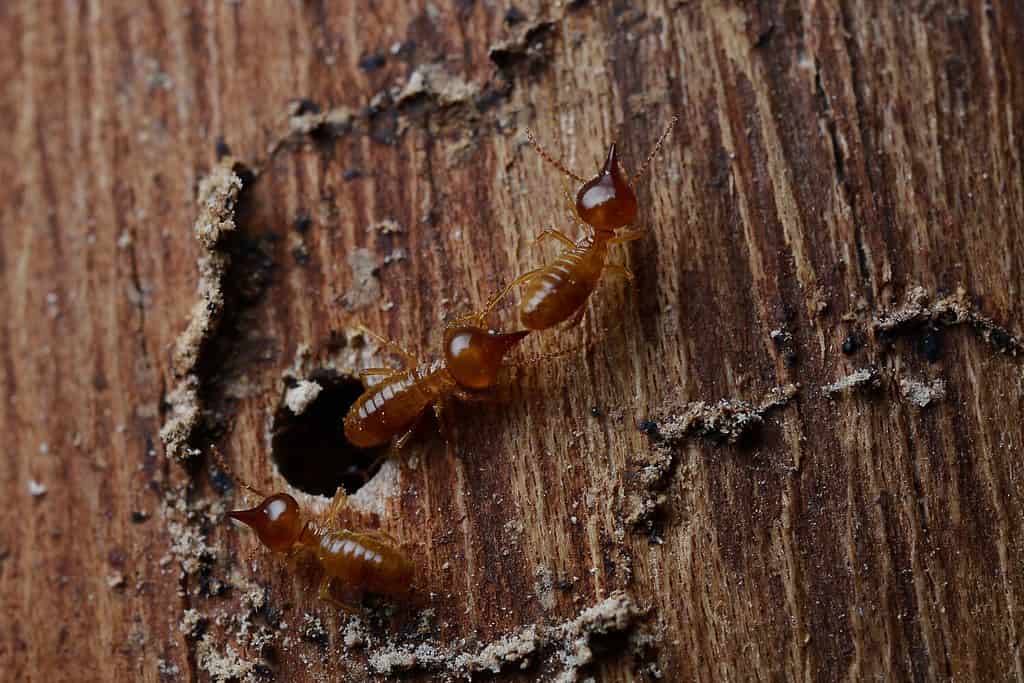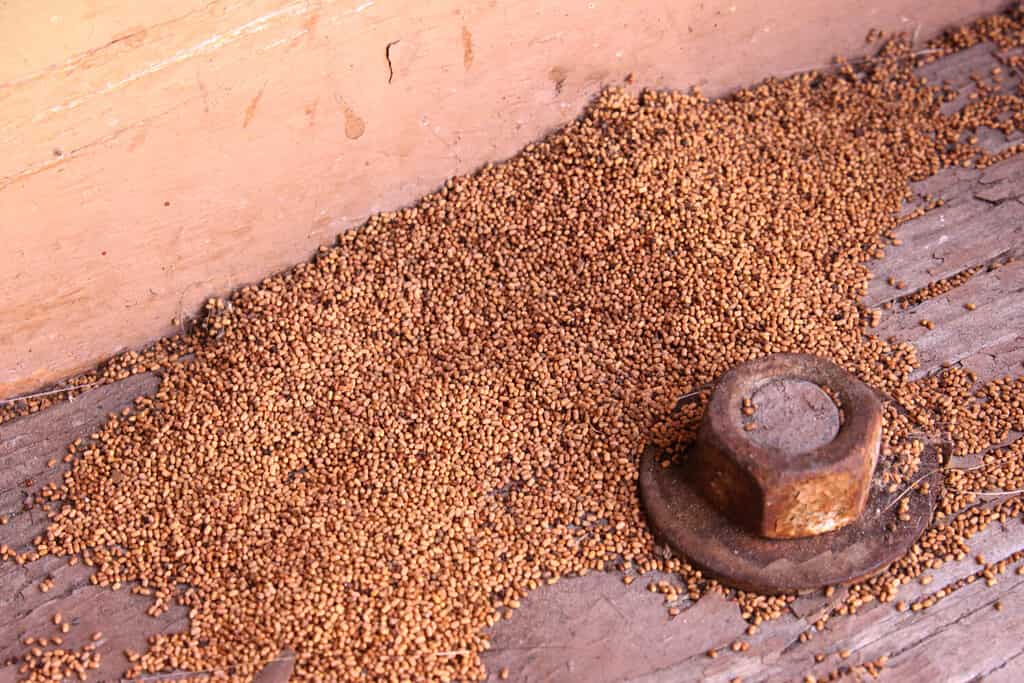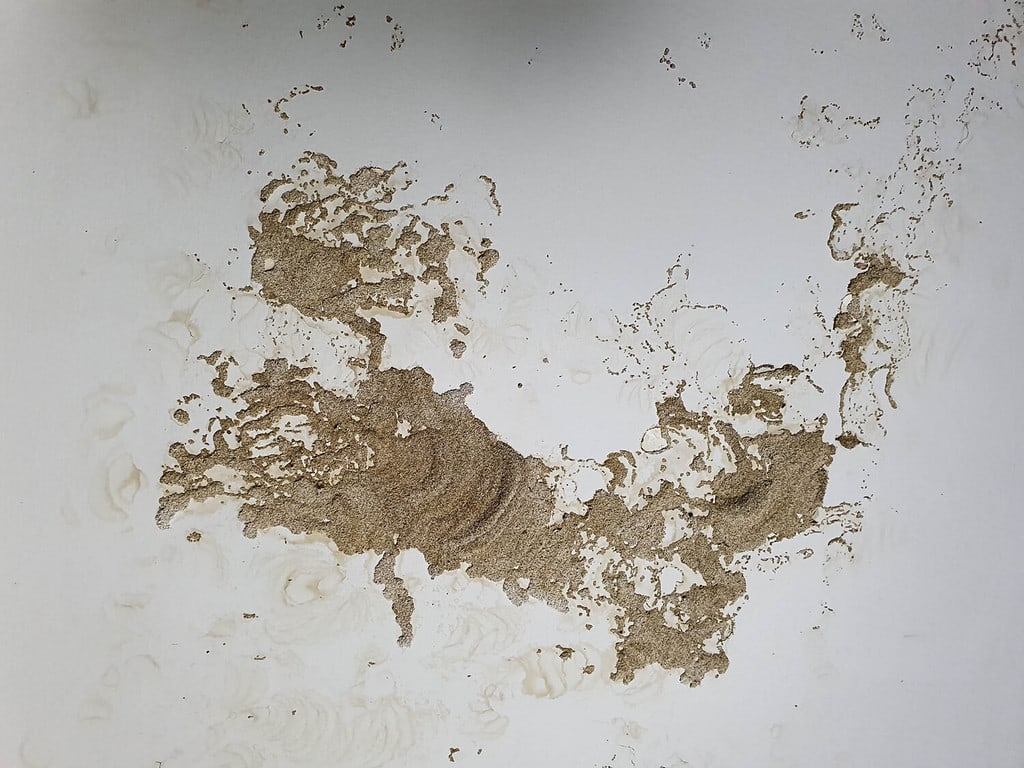Nothing quite scares a homeowner as much as the word “termite.” And for good reason: they cost American homeowners an estimated $5 billion every year. These little relatives of cockroaches can slip into the tiniest cracks and feast on everything made of wood in a house. That means 2x4s, subflooring, rafters, decorative molding, EVERYTHING. Worst of all, they leave a thin outer layer of wood untouched to protect themselves, keeping them hidden. This allows them to multiply and munch on your house for decades until finally, a piece of wood gives way, like the stair beneath your feet or the ceiling above your head! Fortunately, there are some tell-tale signs that indicate you may have termites. This article will focus specifically on 10 ways you can detect a termite infestation in your ceiling. It’s information you need to know, if you want to keep a roof over your head.

Termites are known as “silent destroyers” because of their ability to chew through wood, flooring, and even wallpaper undetected.
©Mr.Parichat chaikuad/Shutterstock.com
Signs of Termite Infestation in your Ceiling
Ceilings are made of a lot of different materials, depending on the age and architectural style of the building. Termites don’t eat ceiling tiles as those are made of inorganic matter. In typical suburban homes, you’ll likely have drywall nailed to wooden beams and joists. Obviously, the wooden supporting structure makes a good meal. But even though drywall is made mainly of plaster, termites will eat the outer paper covering of a sheet of drywall.
1. Noises
Like ants or bees, termites have specialized functions. Soldier termites listen and watch for danger and signal the rest of the colony by banging their heads against a solid surface, like walls or ceilings. A person with exceptional hearing, or using a stethoscope, may notice a clicking noise if the colony has been disturbed.
2. Holes

Small holes are a tell-tale sign of an infestation of some sort . . . possibly termites.
©phadpangpang/Shutterstock.com
If your ceiling is made of drywall, you might start to notice small pinholes in it, sometimes called “kickout holes.” These are where the colony expels waste, such as feces. Sometimes the holes are big enough that termites themselves will fall through them.
3. Cracks, Buckles, or Sagging
If termites are eating their way through structural beams holding up your ceiling, you might notice a ceiling beginning to crack, buckle, or bow down. This can be a sign that the supports of your ceiling are weakening to the point they cannot continue holding the weight up.
4. Tubes

Termite tubes allow them to travel from place to place protected from the elements or predators.
©Chaikom/Shutterstock.com
Termites make a couple of different types of tubes. Drop tubes are 3-4 inch long tubes about the size of a pencil that extend down from a ceiling. Termites make these to try to make contact with moisture for their colony. They also build mud tubes up walls toward the ceiling as protected routes to move from the colony down to the ground and back. These can be on the inside or outside of the structure.
5. Droppings

Termite droppings pile up beneath holes and can indicate an infestation.
©S and S Imaging/Shutterstock.com
Termites make fecal pellets known as “frass.” They push these out of their nest through small holes. You’ll notice little specks that can be light or dark brown and look like coffee grounds or pepper. So when the termites have been cleaning their house, you may notice the need to clean yours . . .
6. Lines on Drywall
Termite trails on drywall can leave raised lines that look like a map from the outside. You might even be able to follow them to get an idea of where the main infestation is.
7. Wings

If you find leftover wings lying around your house, in the best case scenario, they were left by fairies. But it’s more likely they were left by termites.
©galuhtati/Shutterstock.com
After a colony is well-established, they begin to fly around and mate, usually in Spring after a rain. After fertilization, flying termites establish new colonies and shed their wings. Finding tiny wings around your house or yard is a pretty good indication you have one or more mature colonies somewhere on your property.
8. Hollow, Soft Wood
Termite-damaged wood has a hollow sound when you knock on it. if your ceiling or crown molding is made of wood panels or planks, you can rap on it repeatedly over some distance and listen for a change in the sound of it when you’re over a hollow spot. It may also feel soft when you push on it.
9. Mud spotting

Mud spotting on a ceiling like this is a sign of termites.
©duen DD/Shutterstock.com
Termite damage to a ceiling often looks like light water damage. So in addition to buckling paint and drywall surfaces and a sagging ceiling, you might notice also notice brown spots that look like mud splattered on the ceiling.
10. Bubbling or Peeling Paint
As termites work their way along the surface of painted drywall, they can cause paint to bubble up and peel off. The look is similar to what would happen in case of a water leak.
What Can You Do About a Termite Infestation?
Do-It-Yourself Approach

Neem oil, mixed with water and dish soap, can be an effective termite spray to use on small infestations.
©iStock.com/Ninetechno
For a variety of reasons, you might want to take a do-it-yourself approach. For example, the infestation might be in an untreated shed or cabin that isn’t close to your house, and not something you want to spend a lot of money on. Here are some things you can try:
- Termiticides in foam or dust form can reach termites in cracks and kill upon contact. They can be harmful to pets and children, so use them cautiously.
- Liquid termiticides sprayed around the home can create a barrier. Pesticides like fipronil and imidacloprid will spread from one termite to another to kill the colony.
- Boric acid, sprayed on infested areas and in holes and cracks, can dehydrate and kill termites. This is also harmful to pets and children if ingested, so be careful.
- Termite baits poison individual insects that carry poison back to the colony as food.
- Orange oil or neem oil, mixed with water and dish soap, can be used as a spray for small termite infestations.
- Repair wood by drilling holes into it, filling the holes with termiticide, and sealing with putty.
- Outdoors, add nematodes to the soil near where termites are building their tubes up the side of the structure. These are tiny worms that burrow into termites and kill them.
A Professional Exterminator

An exterminator can help you find safe ways to eliminate termites that won’t endanger pets and children.
©hedgehog94/Shutterstock.com
If you suspect a termite infestation, by all means, call an exterminator to confirm your suspicion and determine the extent of the damage. On average, American homeowners can expect to pay about $3,000 to eradicate a termite infestation and treat a home so they don’t come back. It’s a lot of money, but it’s just a drop in the bucket compared to the cost of the damage an uncontrolled infestation can cause.
Maybe you think with some of the pesticides available that can kill the colony, what’s the point of hiring a professional? Professionals will be able to look at your situation and where pets and children, if any, are active in and around your property. They can help you make the safest decisions about using different pesticides. Remember too, you might have multiple colonies in different parts of the house, and their activity can be undetectable for decades. A DIY approach might give you a false sense of security, only to discover years later you’ve made a costly mistake. In the long run, you’ll have more peace of mind knowing your house is truly termite-free.
Thank you for reading! Have some feedback for us? Contact the AZ Animals editorial team.








